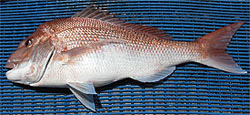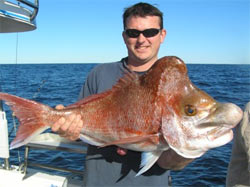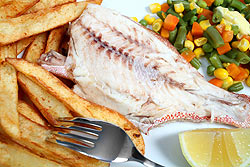Mariculture in South Australia
Snapper
Snapper (Pagrus auratus) are found along the south coast of Australia and as far north as near Exmouth in Western Australia, and near Rockhampton in Queensland. It is also found on Tasmanian coast but in smaller numbers. The fish spawn in inshore waters. Young snapper usually live in estuaries, while adults live in offshore rocky areas and reefs of up to 200 m deep. They school, and will migrate between reefs. Larger fish are known to enter estuaries and harbours, for example Port Phillip Bay has a renowned seasonal snapper run.
The red sea bream found in southern Japanese and Chinese waters is exactly the same species.
|

|
| |
|
They become sexual mature when they reach about 30 cm in length and a small percentage of the males will turn into females at puberty. On reaching adulthood, all snapper develop fleshy bumps on the forehead, while the males grow bumps on their noses. Why they do this is unknown, though males have been observed nudging females with their snouts at breeding time, perhaps to encourage egg release. They are quite slow growing, for example a snapper at the maximum size of 1.3 m long and 20 kg is probably 50 years old.
Snapper are carnivores and spend most time swimming close to the sea bed. They eat a widely varied diet, including fish, crustaceans, worms, molluscs and jellyfish. Though snapper are near the top of the food chain, they may be prey for large fish like estuary cod, dolphins and sharks. A female snapper may spawn a million eggs per season, released in batches during the spawning season. In colder Southern waters, snapper usually spawn in late spring and summer while those living in warmer northern waters spawn in winter. |

|
| |
|
Fertilised eggs may drift for two days before hatching, and like the free-swimming larvae, are affected by currents. Adults migrate inshore to spawn and some larvae will settle as juveniles in sheltered embayments. As with most fish, very few eggs or larvae survive to become adults.
They are very popular with recreational anglers and is also fished for by commercial fishers. Their mild flavored taste and flaky texture make them a very popular eating fish. Snapper are sold whole and as fillets within Australia, and overseas exports to Japan, Taiwan, USA and Italy, began in the mid-1980s. |

|
Next: Farming snapper |
|